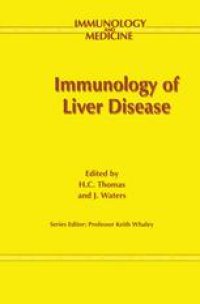
Ebook: Immunology of Liver Disease
- Tags: Immunology, Hepatology
- Series: Immunology and Medicine Series 21
- Year: 1994
- Publisher: Springer Netherlands
- Edition: 1
- Language: English
- pdf
The role of the immune response in both the pathology of liver disease and in the modulation ofliver injury has been the subject of intense research. This book aims to present the current understanding of the involvement of the immune response in liver disease. The first chapters examine the role of the immune response in viral infections of the liver. These viruses cause hepatitis of varying severity and it is thought that many of the mechanisms responsible for liver cell injury are immunologically mediated. In addition three of these viruses, hepatitic B, C, and D, are associated with persistent infection and chronic liver disease. The role of the immune response in viral persistence is discussed. Further chapters are devoted to the three major autoimmune liver diseases which are thought to be the result of loss of tolerance to autologous liver tissue. There has been much recent research on cellular immune responses in these diseases but knowledge of the immunological processes which lead to the breakdown of tolerance and the mechanisms of tissue damage are limited. Other research has concentrated on the identification of the antigens which are the targets of this immune response. Linkage disequilibrium between MHC alleles and autoimmune diseases has suggested a role for immunogenetic factors.
The contributions to this book examine the role of the immune response in liver disease. The book is divided into three sections and there are two introductory chapters: one discussing viral immunopathology and the other autoimmune disease. Three chapters are devoted to viral hepatitis infections, the immune responses engendered by each virus and the pathogenesis of the diseases they cause. One author reviews the use of immunotherapy in hepatocellular carcinoma.
Two chapters then review the recent advances in the identification and characterisation of autoantibodies and their cytoplasmic antigens. These concentrate on new experimental approaches using molecular biological techniques to identify the structures recognised by disease-specific autoantibodies.
The third section has a chapter reviewing the immune mechanisms in alcoholic liver disease and a chapter examining the immune reactions provoked by hepatotoxic drugs.